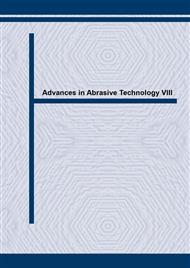p.381
p.385
p.389
p.395
p.401
p.407
p.413
p.419
p.425
Nano Mechanical Processing of Silicon by Atomic Force Microscopy
Abstract:
Nanometer-scale protuberance and groove processing was performed on a silicon (Si) surface by diamond tip sliding using atomic force microscopy (AFM). The protuberances of 0-5 nm height were obtained the silicon surface by using the diamond tip of approximately 200 nm radius and the grooves of 0-2 nm depth were processed by the tip of about 50 nm radius. It was observed that both protuberance and groove were produced using the tip of about 100 nm radius. Indentation measurements show the hardness of processed parts was greater than that of unprocessed parts. Potassium hydroxide (KOH) solution etching was performed on the mechanochemically processed sample. The processed areas were prevented from etching due to the formation of a dense oxide layer. This may be because the processed parts were oxidized by tip sliding due to the effect of mechanochemical oxidation.
Info:
Periodical:
Pages:
401-406
Citation:
Online since:
August 2005
Price:
Сopyright:
© 2005 Trans Tech Publications Ltd. All Rights Reserved
Share:
Citation:


